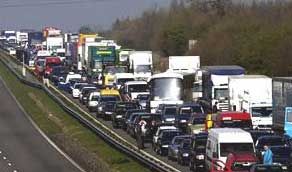SmartNav Reviewed
Simon Rockman tries out the navigation, blackspot and tracking system from Trafficmaster
Trafficmaster’s SmartNav is a car navigation system that uses a mobile phone connection to replace a lot of the equipment usually associated with sat-nav. The hardware still uses satellite positioning so it knows where you are. It also knows how fast you are going and best of all it has a database of Gatsos and speed cameras. Er, sorry - ‘Accident Black spots’ as indicated by Gatsos and speed cameras. The latest device can also be linked into a stolen vehicle tracking system.

The substitution of a mobile phone for the computer and CD system halves the price when compared to a traditional nav system. It also works better and is easier to use.
The one-button approach is one of the things that makes SmartNav special. It’s like using carphones of the early 1980s. These didn’t have a keypad. You just picked up the handset, pressed the walkie-talkie type button and spoke to an operator. You asked for the number and the operator put you through. With SmartNav, too, you press one button and speak to an operator.
Found You
The car sends the GPS position to the operator at Trafficmaster by text message and the software at HQ works out which road you are on. All you have to do is say where you want to go. The operator enters this into the computer system, which then works out the route and sends it as data, like an email, to the car. The small computer in the car takes the route and reads out instructions.
There is no screen, only a hidden speaker, a mobile phone car kit microphone and one Trafficmaster button. Since most cars have blanking plates for options which didn’t come on your model, the button can usually be made to look in keeping with the rest of the controls on the car. Trafficmaster keeps a stock of suitably sized and shaped buttons. Just having one button makes the unit ideal for particularly smart cars where you don’t want to spoil the look of the interior with third party hardware. The button can even be out of sight under a seat! Indeed Trafficmaster has looked at the possibility of putting a second button in just such a position as a car-jacking protection.
Live Data
 The route which is downloaded into your car takes into account the latest traffic conditions. This is Trafficmaster’s forte. There are around 8000 miles of roads in the UK, which are constantly monitored by Trafficmaster’s sensors. On motorway bridges are simple infra-red sensors that measure the speed of the cars below by bouncing a signal off the front of the cars. On suburban roads, there are blue poles containing digital cameras which read part of the number plate.
The route which is downloaded into your car takes into account the latest traffic conditions. This is Trafficmaster’s forte. There are around 8000 miles of roads in the UK, which are constantly monitored by Trafficmaster’s sensors. On motorway bridges are simple infra-red sensors that measure the speed of the cars below by bouncing a signal off the front of the cars. On suburban roads, there are blue poles containing digital cameras which read part of the number plate.
Trafficmaster has a database of regular jams and blackspots built up over 10 years of monitoring traffic. If your journey takes you past a place that is free when you ask for the route, but likely to be jammed by the time you reach it, the route will divert around a traffic jam that isn’t there yet.
Your connection to the Trafficmaster server takes less than two minutes so you've not online all the time. If, however, there is an accident which will block your route, the Trafficmaster computer estimates where you are, calls up to find out and then gives you a new, faster route. Of course Trafficmaster doesn’t have sensors everywhere so it uses a database of previous traffic for those roads.
Up to Date
The combination of all this information should give you the optimum route for your journey. One of the greatest weaknesses of all navigation systems is that maps are not completely accurate. Even if they start off right, roads change, there are one way systems implemented then the council changes its mind or a mad Mayor chooses to block off half of Trafalgar Square.
If you have a paper map you probably won’t have changed it for about three years. With a CD based navigation system the makers recommend that you buy annual updates. In practice people tend to get the updates every couple of years (just after getting lost due to an old map!). But the updates are typically going to be six months out of date and they are expensive, something around £100. With the Trafficmaster server based system the maps are regularly updated, and if they are wrong there is a free phone number for customers to call in and correct it.
There are still some problems with roads being wrongly categorised, in particular some bumpy farm tracks that are shown as ‘b’ roads. This is a great short cut if you have a Cayenne, not so good in a GT2.
Where Now?
The biggest difference between using a CD based system and SmartNav is that with a CD system you type in the details of where you want to go before you start driving. With SmartNav the system takes a few seconds to get a fix on you so you need to wait before pressing the dial button. You can drive off and do this, but of course if you’ve no idea of which way to turn to start the journey you don’t have any directions to know which way to turn. On balance it is usually nicer to start out and then get directions than fiddle around before you leave.
The other major difference is what happens when you leave the recommended route. A CD-based system would have the whole map to hand, but SmartNav only has the roads you are supposed to be on. When you leave the route the system detects this, and starts calling base. It then tells you that you are no longer on the route and downloads a new route. This all happens reasonably quickly but it can be a little disconcerting to feel lost for a few hundred yards.
Cameras
The ‘accident black spot’ side of things works even if you are not being navigated on a route. If you need to be advised that the road is ‘dangerous’ there are three gentle beeps. It’s an intelligent system and only warns for the right direction. If you are traveling too fast – again measured by the wonders of GPS – then the beeps are louder and more urgent. It keeps beeping until you slow down. The indication cannot be turned on and off which is a pain when you have passengers who are asleep, and on the M25 which seems to have more cameras than the BBC. The unit keeps the map of cameras updated automatically – you don’t have to specifically dial in, but does not track mobile units.
A more fully featured, more expensive version of SmartNav that uses an in-car screen is also under development. Without visual input, there are times when the voice only input can be imprecise—it might not be clear which road is meant by ‘the third exit on the roundabout’, for instance. SmartNav gives road numbers but not names, which can throw you—for instance, most people will know the A5183 only as Watling Street.
Web Interface
 Key elements of the SmartNav service can be set up on the web site before you set off. This is excellent. It allows you to save common locations so that when you call up you can just say ‘Home’ or ‘Work’. The site also lets you set certain parameters. You can say whether you you prefer A-roads or motorways and you can specify the length of delay that will necessitate a re-route. Using one payment method, you are charged for each re-route, so it’s good to be able to choose to put up with minor traffic jams if you wish.
Key elements of the SmartNav service can be set up on the web site before you set off. This is excellent. It allows you to save common locations so that when you call up you can just say ‘Home’ or ‘Work’. The site also lets you set certain parameters. You can say whether you you prefer A-roads or motorways and you can specify the length of delay that will necessitate a re-route. Using one payment method, you are charged for each re-route, so it’s good to be able to choose to put up with minor traffic jams if you wish.
There are also maps which show recent journeys and the option to set a personal greeting. If you share your car your spouse might not want to be greeted with your name.
The control centre can do more than just arrange routes and breakdown services. You can order presents and flowers through the concierge service which feels very smart.
When Mercury One 2 One first launched there were services like this and I used it to order flowers for a girl. We are married now :)
SmartNav doesn’t guarantee true love, but it doesn’t cost a bomb either. The basic system costs £500 plus installation—expect that to be around £80 depending on who does it and how tricky your car is to take apart and put back together. There is also an annual charge or a charge per route. This includes the cost of the phone call (SmartNav uses O2 for the connection). Calls can only be made to the SmartNav control centre and it won’t accept incoming calls from anyone except Trafficmaster.
The service charge is £350 for life, £120 a year or 89p a route (plus 20p for each re-route). The system comes with the first 15 routes free so you can try it out and then decide which tariff you want. The blackspot warning costs an extra £6 a month and there is an optional stolen vehicle service that costs £8 a month.
SmartNav contact: 0870 240 5000 www.smartnav.com
Gassing Station | General Gassing [Archive] | Top of Page | What's New | My Stuff



